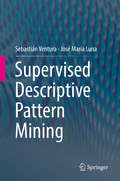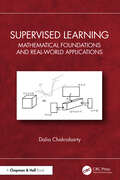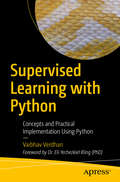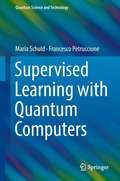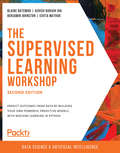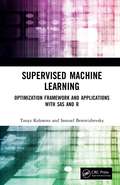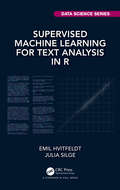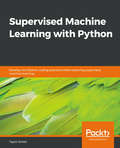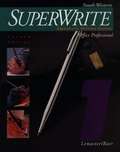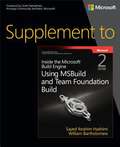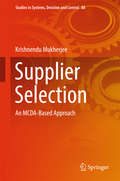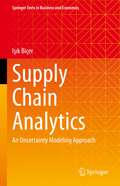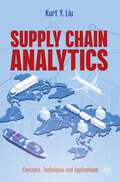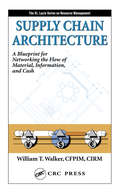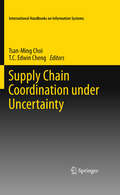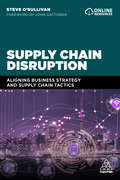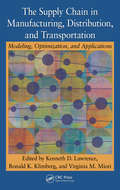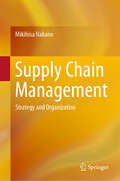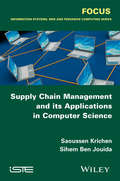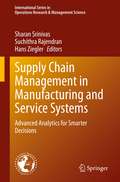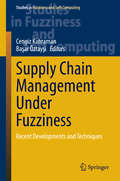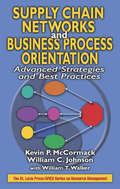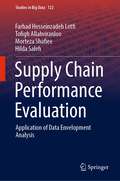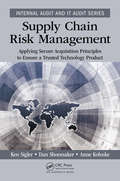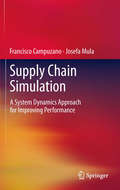- Table View
- List View
Supervised Descriptive Pattern Mining
by Sebastián Ventura José María LunaThis book provides a general and comprehensible overview of supervised descriptive pattern mining, considering classic algorithms and those based on heuristics. It provides some formal definitions and a general idea about patterns, pattern mining, the usefulness of patterns in the knowledge discovery process, as well as a brief summary on the tasks related to supervised descriptive pattern mining. It also includes a detailed description on the tasks usually grouped under the term supervised descriptive pattern mining: subgroups discovery, contrast sets and emerging patterns. Additionally, this book includes two tasks, class association rules and exceptional models, that are also considered within this field.A major feature of this book is that it provides a general overview (formal definitions and algorithms) of all the tasks included under the term supervised descriptive pattern mining. It considers the analysis of different algorithms either based on heuristics or based on exhaustive search methodologies for any of these tasks. This book also illustrates how important these techniques are in different fields, a set of real-world applications are described.Last but not least, some related tasks are also considered and analyzed. The final aim of this book is to provide a general review of the supervised descriptive pattern mining field, describing its tasks, its algorithms, its applications, and related tasks (those that share some common features).This book targets developers, engineers and computer scientists aiming to apply classic and heuristic-based algorithms to solve different kinds of pattern mining problems and apply them to real issues. Students and researchers working in this field, can use this comprehensive book (which includes its methods and tools) as a secondary textbook.
Supervised Learning: Mathematical Foundations and Real-world Applications
by Dalia ChakrabartyThis book discusses the relevance of probabilistic supervised learning, to the pursuit of automated and reliable prediction of an unknown that is in a state of relationship with another variable. The book provides methods for secured mechanistic learning of the function that represents this relationship between the output and input variables, where said learning is undertaken within the remit of real-world information that can be messy in different ways. For example, the available data may be highly multivariate or be high-dimensional, reflecting the nature of the output variable that could be a vector, or matrix, or even higher in dimension, as is often the case in a real-world application. Additionally, the data is noisy, and often it is small to moderately large in size in multiple applications. Another difficulty that regularly arises is that the training dataset – comprising pairs of values of the input and output –is such, that the sought function cannot be captured by a parametric shape, but is instead underlined by an inhomogeneous correlation structure. These difficulties notwithstanding, we desire a streamlined methodology that allows the learning of the inter variable relationship – to ultimately permit fast and reliable predictions of the output, at newly recorded values of the input. In fact, occasions arise when one seeks values of the input at which a new output value is recorded, and such a demand is also addressed in the book.The generic solution to the problem of secured supervised learning amidst real-world messiness, lies in treating the sought inter-variable relation as a (function-valued) random variable, which, being random, is ascribed a probability distribution. Then recalling that distributions on the space of functions are given by stochastic processes, the sought function is proposed to be a sample function of a stochastic process. This process is chosen as one that imposes minimal constraints on the sought function – identified as a Gaussian Process (GP) in the book. Thus, the sought function can be inferred upon, as long as the co-variance function of the underlying GP is learnt, given the available training set. The book presents probabilistic techniques to undertake said learning, within the challenges borne by the data, and illustrates such techniques on real data. Learning of a function is always followed by closed-form prediction of the mean and dispersion of the output variable that is realised at a test input. To help with the background, the book includes reviews on stochastic processes and basic probability theory. This will render the first half of the book useful for students across disciplines, while the latter half will be appreciated by students of numerate subjects at the postgraduate level or higher, including students of computational sciences, statistics and mathematics.
Supervised Learning with Python: Concepts and Practical Implementation Using Python
by Vaibhav VerdhanGain a thorough understanding of supervised learning algorithms by developing use cases with Python. You will study supervised learning concepts, Python code, datasets, best practices, resolution of common issues and pitfalls, and practical knowledge of implementing algorithms for structured as well as text and images datasets.You’ll start with an introduction to machine learning, highlighting the differences between supervised, semi-supervised and unsupervised learning. In the following chapters you’ll study regression and classification problems, mathematics behind them, algorithms like Linear Regression, Logistic Regression, Decision Tree, KNN, Naïve Bayes, and advanced algorithms like Random Forest, SVM, Gradient Boosting and Neural Networks. Python implementation is provided for all the algorithms. You’ll conclude with an end-to-end model development process including deployment and maintenance of the model.After reading Supervised Learning with Python you’ll have a broad understanding of supervised learning and its practical implementation, and be able to run the code and extend it in an innovative manner.What You'll LearnReview the fundamental building blocks and concepts of supervised learning using PythonDevelop supervised learning solutions for structured data as well as text and images Solve issues around overfitting, feature engineering, data cleansing, and cross-validation for building best fit modelsUnderstand the end-to-end model cycle from business problem definition to model deployment and model maintenance Avoid the common pitfalls and adhere to best practices while creating a supervised learning model using PythonWho This Book Is ForData scientists or data analysts interested in best practices and standards for supervised learning, and using classification algorithms and regression techniques to develop predictive models.
Supervised Learning with Quantum Computers (Quantum Science and Technology)
by Maria Schuld Francesco PetruccioneQuantum machine learning investigates how quantum computers can be used for data-driven prediction and decision making. The books summarises and conceptualises ideas of this relatively young discipline for an audience of computer scientists and physicists from a graduate level upwards. It aims at providing a starting point for those new to the field, showcasing a toy example of a quantum machine learning algorithm and providing a detailed introduction of the two parent disciplines. For more advanced readers, the book discusses topics such as data encoding into quantum states, quantum algorithms and routines for inference and optimisation, as well as the construction and analysis of genuine ``quantum learning models''. A special focus lies on supervised learning, and applications for near-term quantum devices.
The Supervised Learning Workshop: A New, Interactive Approach to Understanding Supervised Learning Algorithms, 2nd Edition
by Benjamin Johnston Ishita Mathur Blaine Bateman Ashish Ranjan JhaCut through the noise and get real results with a step-by-step approach to understanding supervised learning algorithms Key Features Ideal for those getting started with machine learning for the first time A step-by-step machine learning tutorial with exercises and activities that help build key skills Structured to let you progress at your own pace, on your own terms Use your physical print copy to redeem free access to the online interactive edition Book Description You already know you want to understand supervised learning, and a smarter way to do that is to learn by doing. The Supervised Learning Workshop focuses on building up your practical skills so that you can deploy and build solutions that leverage key supervised learning algorithms. You'll learn from real examples that lead to real results. Throughout The Supervised Learning Workshop, you'll take an engaging step-by-step approach to understand supervised learning. You won't have to sit through any unnecessary theory. If you're short on time you can jump into a single exercise each day or spend an entire weekend learning how to predict future values with auto regressors. It's your choice. Learning on your terms, you'll build up and reinforce key skills in a way that feels rewarding. Every physical print copy of The Supervised Learning Workshop unlocks access to the interactive edition. With videos detailing all exercises and activities, you'll always have a guided solution. You can also benchmark yourself against assessments, track progress, and receive content updates. You'll even earn a secure credential that you can share and verify online upon completion. It's a premium learning experience that's included with your printed copy. To redeem, follow the instructions located at the start of your book. Fast-paced and direct, The Supervised Learning Workshop is the ideal companion for those with some Python background who are getting started with machine learning. You'll learn how to apply key algorithms like a data scientist, learning along the way. This process means that you'll find that your new skills stick, embedded as best practice. A solid foundation for the years ahead. What you will learn Get to grips with the fundamental of supervised learning algorithms Discover how to use Python libraries for supervised learning Learn how to load a dataset in pandas for testing Use different types of plots to visually represent the data Distinguish between regression and classification problems Learn how to perform classification using K-NN and decision trees Who this book is for Our goal at Packt is to help you be successful, in whatever it is you choose to do. The Supervised Learning Workshop is ideal for those with a Python background, who are just starting out with machine learning. Pick up a Workshop today, and let Packt help you develop skills that stick with you for life.
Supervised Machine Learning: Optimization Framework and Applications with SAS and R
by Tanya Kolosova Samuel BerestizhevskyAI framework intended to solve a problem of bias-variance tradeoff for supervised learning methods in real-life applications. The AI framework comprises of bootstrapping to create multiple training and testing data sets with various characteristics, design and analysis of statistical experiments to identify optimal feature subsets and optimal hyper-parameters for ML methods, data contamination to test for the robustness of the classifiers. Key Features: Using ML methods by itself doesn’t ensure building classifiers that generalize well for new data Identifying optimal feature subsets and hyper-parameters of ML methods can be resolved using design and analysis of statistical experiments Using a bootstrapping approach to massive sampling of training and tests datasets with various data characteristics (e.g.: contaminated training sets) allows dealing with bias Developing of SAS-based table-driven environment allows managing all meta-data related to the proposed AI framework and creating interoperability with R libraries to accomplish variety of statistical and machine-learning tasks Computer programs in R and SAS that create AI framework are available on GitHub
Supervised Machine Learning for Text Analysis in R (Chapman & Hall/CRC Data Science Series)
by Emil Hvitfeldt Julia SilgeText data is important for many domains, from healthcare to marketing to the digital humanities, but specialized approaches are necessary to create features for machine learning from language. Supervised Machine Learning for Text Analysis in R explains how to preprocess text data for modeling, train models, and evaluate model performance using tools from the tidyverse and tidymodels ecosystem. Models like these can be used to make predictions for new observations, to understand what natural language features or characteristics contribute to differences in the output, and more. If you are already familiar with the basics of predictive modeling, use the comprehensive, detailed examples in this book to extend your skills to the domain of natural language processing. This book provides practical guidance and directly applicable knowledge for data scientists and analysts who want to integrate unstructured text data into their modeling pipelines. Learn how to use text data for both regression and classification tasks, and how to apply more straightforward algorithms like regularized regression or support vector machines as well as deep learning approaches. Natural language must be dramatically transformed to be ready for computation, so we explore typical text preprocessing and feature engineering steps like tokenization and word embeddings from the ground up. These steps influence model results in ways we can measure, both in terms of model metrics and other tangible consequences such as how fair or appropriate model results are.
Supervised Machine Learning with Python: Develop rich Python coding practices while exploring supervised machine learning
by Taylor SmithTeach your machine to think for itself!Key FeaturesDelve into supervised learning and grasp how a machine learns from dataImplement popular machine learning algorithms from scratch, developing a deep understanding along the wayExplore some of the most popular scientific and mathematical libraries in the Python languageBook DescriptionSupervised machine learning is used in a wide range of sectors (such as finance, online advertising, and analytics) because it allows you to train your system to make pricing predictions, campaign adjustments, customer recommendations, and much more while the system self-adjusts and makes decisions on its own. As a result, it's crucial to know how a machine “learns” under the hood.This book will guide you through the implementation and nuances of many popular supervised machine learning algorithms while facilitating a deep understanding along the way. You’ll embark on this journey with a quick overview and see how supervised machine learning differs from unsupervised learning. Next, we explore parametric models such as linear and logistic regression, non-parametric methods such as decision trees, and various clustering techniques to facilitate decision-making and predictions. As we proceed, you'll work hands-on with recommender systems, which are widely used by online companies to increase user interaction and enrich shopping potential. Finally, you’ll wrap up with a brief foray into neural networks and transfer learning.By the end of this book, you’ll be equipped with hands-on techniques and will have gained the practical know-how you need to quickly and powerfully apply algorithms to new problems.What you will learnCrack how a machine learns a concept and generalize its understanding to new dataUncover the fundamental differences between parametric and non-parametric modelsImplement and grok several well-known supervised learning algorithms from scratchWork with models in domains such as ecommerce and marketingExpand your expertise and use various algorithms such as regression, decision trees, and clusteringBuild your own models capable of making predictionsDelve into the most popular approaches in deep learning such as transfer learning and neural networksWho this book is forThis book is for aspiring machine learning developers who want to get started with supervised learning. Intermediate knowledge of Python programming—and some fundamental knowledge of supervised learning—are expected.
Superwrite: Alphabetic Writing System, Office Professional (Volume 1, 2nd Edition)
by A. James Lemaster John BaerVolume One introduces SuperWrite theory and beginning transcription principles. The step-by-step approach to writing principles guides students to alphabetic writing success. Eight lessons develop personal success factors such as goal-setting, problem-solving, time management, attendance, and promptness. Updated keyboarding style references reflect current business practices.
Supplement to Inside the Microsoft® Build Engine: Using MSBuild and Team Foundation Build
by William Bartholomew Sayed Ibrahim HashimiGet the supplement that helps you drill even further into MSBuild--and maximize your control over the software build and deployment process. Designed as a companion to the popular book Inside the Microsoft Build Engine: Using MSBuild and Team Foundation Build, Second Edition, this supplement extends your knowledge by covering what's new in Visual Studio 2012 for MSBuild and Team Foundation Build. You'll also gain a fresh cookbook of examples to help you get productive with UI changes, batching, Team Foundation Server, offline apps, database publishing, and other essential topics. Extends your knowledge of MSBuild with all-new coverage of Visual Studio 2012 Shares additional hands-on insights and guidance from two expert authors Provides a cookbook of examples to study and reuse
Supplier Selection
by Krishnendu MukherjeeThe purpose of this book is to present a comprehensive review of the latest research and development trends at the international level for modeling and optimization of the supplier selection process for different industrial sectors. It is targeted to serve two audiences: the MBA and PhD student interested in procurement, and the practitioner who wishes to gain a deeper understanding of procurement analysis with multi-criteria based decision tools to avoid upstream risks to get better supply chain visibility. The book is expected to serve as a ready reference for supplier selection criteria and various multi-criteria based supplier's evaluation methods for forward, reverse and mass customized supply chain. This book encompasses several criteria, methods for supplier selection in a systematic way based on extensive literature review from 1998 to 2012. It provides several case studies and some useful links which can serve as a starting point for interested researchers. In the appendix several computer code written in MatLab and VB. NET is also included for the interested reader. Lucid explosion of various techniques used to select and evaluate suppliers is one of the unique characteristic of this book. Moreover, this book gives in depth analysis of selection and evaluation of suppliers for traditional supply chain, closed loop supply chain, supply chain for customized product, green supply chain, sustainable supply chain and also depicts methods for supply base reduction and selection of large number of suppliers.
Supply Chain Analytics: An Uncertainty Modeling Approach (Springer Texts in Business and Economics)
by Işık BiçerThis textbook offers a detailed account of analytical models used to solve complex supply chain problems. It introduces a unique risk analysis framework that helps the reader understand the sources of uncertainties and use appropriate models to improve decisions in supply chains. This framework illustrates the complete supply chain for a product and demonstrates the supply chain's exposure to demand, supply, inventory, and financial risks. Step by step, this book provides a detailed examination of analytical methods that optimize operational decisions under different types of uncertainty. It discusses stochastic inventory models, introduces uncertainty modeling methods, and explains methods for managing uncertainty. To help readers deepen their understanding, it includes access to various supplementary material including an online interactive tool in Python. This book is intended for undergraduate and graduate students of supply chain management with a focus on supply chain analytics. It also prepares practitioners to make better decisions in this field.
Supply Chain Analytics: Concepts, Techniques and Applications
by Kurt Y. LiuThis innovative new core textbook, written by an experienced professor and practitioner in supply chain management, offers a business-focused overview of the applications of data analytics and machine learning to supply chain management. Accessible yet rigorous, this text introduces students to the relevant concepts and techniques needed for data analysis and decision making in modern supply chains and enables them to develop proficiency in a popular and powerful programming software. Suitable for use on upper-level undergraduate, postgraduate and MBA courses in supply chain management, it covers all of the major supply chain processes, including managing supply and demand, warehousing and inventory control, transportation and route optimization. Each chapter comes with practical real-world examples drawn from a range of business contexts, including Amazon and Starbucks, case study discussion questions, computer-assisted exercises and programming projects.
Supply Chain Architecture: A Blueprint for Networking the Flow of Material, Information, and Cash (Resource Management)
by William T. Walker"The book is highly readable, informative, thought provoking, and educational.At every stage, Walker challenges the reader to move away from conventional supply chain thinking to a broader-view, highly concise approach that focuses on the organization's objectives. The book will help you visualize a supply network and develop a blueprint for your
Supply Chain Coordination under Uncertainty
by T.C. Edwin Cheng Tsan-Ming ChoiChannel coordination is a core subject of supply chain management. Over the past decade, much research effort has been devoted to exploring the detailed mechanisms for achieving supply chain coordination under uncertainty, generating many fruitful analytical and empirical results. Despite the abundance of research results, there is an absence of a comprehensive reference source that provides state-of-the-art findings on both theoretical and applied research on the subject. In addition, with the advance of knowledge and technologies, many new topics on supply chain coordination under uncertainty have appeared in recent years. This handbook extensively examines supply chain coordination challenges with a focal point on discovering innovative measures that can help tackle the existing and emerging challenges. The book is organized into five parts, which include chapters on innovative analytical models for coordination, channel power and bargaining, technological advancements and applications, empirical analysis, cases studies and review. This handbook provides new empirical and analytical results with precious insights, which will not only help supply chain agents to understand more about the latest measures for supply chain coordination under uncertainty, but also help practitioners and researchers to know how to improve supply chain performance based on innovative methods.
Supply Chain Disruption: Aligning Business Strategy and Supply Chain Tactics
by Steve O'SullivanDisruptive technologies have the power to upend supply chains, adding uncertainty, cost, and complexity to any business. These technologies can also create competitive advantage, but only if organizations strategically build them into their supply chains. Supply Chain Disruption, with a foreword by John Gattorna, provides the vital knowledge that supply chain managers need in order to implement disruptive technologies strategically. This essential book avoids a one-size-fits-all approach and encourages the reader to consider customer needs first before aligning appropriate technologies with each supply chain application.Supply Chain Disruption focuses on information systems, analysing how companies currently integrate and implement potentially disruptive technologies into their supply chain roadmaps. It presents new ways of planning more effectively and efficiently through the use of new tools and techniques, creating improvements in agility, customer service and cost. Online supporting resources include templates for metric-based process models focusing on the key enablers and inhibitors.
The Supply Chain in Manufacturing, Distribution, and Transportation: Modeling, Optimization, and Applications
by Kenneth D. Lawrence Ronald K. Klimberg Virginia M. MioriReporting on cutting-edge research in production, distribution, and transportation, The Supply Chain in Manufacturing, Distribution, and Transportation: Modeling, Optimization, and Applications provides the understanding needed to tackle key problems within the supply chain. Viewing the supply chain as an integrated process with regard to tactical
Supply Chain Management: Strategy and Organization
by Mikihisa NakanoThis book explains supply chain management (SCM) using the strategy–structure–process–performance (SSPP) framework. Utilizing this well-known framework of contingency theory in the areas of strategic management and organizational design, SCM is firmly positioned among management theories. The author specifically proposes a theoretical foundation of SCM that will be relevant to such areas as operations management, logistics management, purchasing management, and marketing. Both the static and dynamic sides of SCM are reported. On the static side, supply chain strategies are divided into three patterns: efficiency-oriented, responsiveness-oriented, and the hybrid efficiency- and responsiveness-oriented pattern. For each strategy, suitable internal and external supply chain structures and processes are proposed. On the dynamic side, the big issue is to overcome performance trade-offs. Based on theories of organizational change, process change, and dynamic capabilities, the book presents a model of supply chain process change. On structure, the focus is on the role of an SCM steering department. Illustrative cases are included from such diverse industries as automobiles (Toyota and Nissan ), personal computers (Fujitsu), office equipment (Ricoh), air-conditioning (Daikin), tobacco (Japan Tobacco), chemicals and cosmetics (Kao), and casual fashion (Fast Retailing and Inditex).The strategy and organization of SCM is systematically presented on the basis of the SSPP framework. In particular, the relationships among three management elements—strategy, structure, and process—can be identified in an SCM context. From many of the cases contained in this volume, there emerges an understanding of how to analyze the success and failure factors of SCM using the SSPP framework. In addition, the reader sees not only the static side SCM such as process operation but also its dynamic side such as process innovation and process improvement.
Supply Chain Management and its Applications in Computer Science
by Saoussen Krichen Sihem Ben JouidaSupply chain management is a key topic for a large variety of strategic decision problems. It is essential in making efficient decisions related to the management of inventory and the delivery of final products to customers. The focus of this book is the understanding of the supply chain taxonomy, the different levels of decision and the impact of one level on another depending on the modeling of the addressed objectives. The authors explore the potential problems that can be addressed within the supply chain, such as the inventory, the transportation and issues of holding, and find applications in numerous fields of study, from cloud computing and networking through to industrial sciences. The reader can find each issue described and its positioning in the supply chain determined. A computer science framework is also developed to show how the use of electronic platforms can aid in the handling of these potential problems.
Supply Chain Management in Manufacturing and Service Systems: Advanced Analytics for Smarter Decisions (International Series in Operations Research & Management Science #304)
by Sharan Srinivas Suchithra Rajendran Hans ZieglerManagement of supply chains has been evolving rapidly over the last few years due to the inception of Industry 4.0, where businesses adopt automation technologies and data exchanges leading to dynamic and interconnected supply chain systems. Emphasizing on analytical approaches such as predictive and prescriptive modeling, this book presents state-of-the-art original research work dealing with advanced analytical models for the design, planning, and operation of the supply chain to provide faster and smarter decisions in the era of digitization. In particular, the book integrates machine learning and operations research models for faster and smarter decisions, presents prescriptive analytics models for strategic, tactical, and operational decision making in the supply chain, and addresses recent challenges such as sustainability in the supply chain, supply chain visibility, and supply chain digitalization. Key concepts are illustrated using real-life case studies, making the book a valuable reference for researchers, technical professionals, and students.
Supply Chain Management Under Fuzziness
by Cengiz Kahraman Başar ÖztayşiSupply Chain Management Under Fuzziness presents recently developed fuzzy models and techniques for supply chain management. These include: fuzzy PROMETHEE, fuzzy AHP, fuzzy ANP, fuzzy VIKOR, fuzzy DEMATEL, fuzzy clustering, fuzzy linear programming, and fuzzy inference systems. The book covers both practical applications and new developments concerning these methods. This book offers an excellent resource for researchers and practitioners in supply chain management and logistics, and will provide them with new suggestions and directions for future research. Moreover, it will support graduate students in their university courses, such as specialized courses on supply chains and logistics, as well as related courses in the fields of industrial engineering, engineering management and business administration.
Supply Chain Networks and Business Process Orientation: Advanced Strategies and Best Practices (Resource Management)
by Kevin P. McCormack William C. JohnsonWith future competitive landscape shifting from competition between companies themselves to trading partner networks, understanding and mastering process design and change is becoming more critical than ever. In order to succeed, companies are starting to weave their key business processes into hard-to-imitate strategic capabilities that distinguis
Supply Chain Performance Evaluation: Application of Data Envelopment Analysis (Studies in Big Data #122)
by Tofigh Allahviranloo Morteza Shafiee Hilda Saleh Farhad Hosseinzadeh LotfiThe authors of this book tried to make these experiences available to those interested, considering the experience of several years of training, research, and implementation of projects in the supply chain performance evaluation field.This book intends to identify the current performance and competitive position of that supply chain compared to other supply chains by presenting and reviewing the techniques and models for measuring the efficiency and performance of the supply chain. Determining the performance of a supply chain is a good description of the status quo (what is). Determining the performance of a supply chain is useful for describing the past and present of supply chain processes, and on the other hand, it can be used to set performance goals and initiate the improvement process. To realize this, a strategic framework or model is needed to be able to extract indicators related to the efficiency of the supply chain and design the appropriate model.
Supply Chain Risk Management: Applying Secure Acquisition Principles to Ensure a Trusted Technology Product (Internal Audit and IT Audit)
by Ken Sigler Dan Shoemaker Anne KohnkeThe book presents the concepts of ICT supply chain risk management from the perspective of NIST IR 800-161. It covers how to create a verifiable audit-based control structure to ensure comprehensive security for acquired products. It explains how to establish systematic control over the supply chain and how to build auditable trust into the products and services acquired by the organization. It details a capability maturity development process that will install an increasingly competent process and an attendant set of activities and tasks within the technology acquisition process. It defines a complete and correct set of processes, activities, tasks and monitoring and reporting systems.
Supply Chain Simulation
by Francisco Campuzano Josefa MulaSupply Chain Simulation allows readers to practice modeling and simulating a multi-level supply chain. The chapters are a combination of the practical and the theoretical, covering: knowledge of simulation methods and techniques,the conceptual framework of a typical supply chain,the main concepts of system dynamics, anda set of practice problems with their corresponding solutions.The problem set includes illustrations and graphs relating to the simulation results of the Vensim® program, the main code of which is also provided. The examples used are a valuable simulation tool that can be modified and extended according to user requirements. The objective of Supply Chain Simulation is to meet the demands of supply chain simulation or similar courses taught at the postgraduate level. The "what if" analysis recreates different simulation scenarios to improve the decision-making process in terms of supply chain performance, making the book useful not only for postgraduate students, but also for industrial practitioners.
